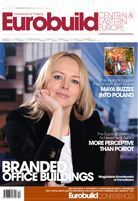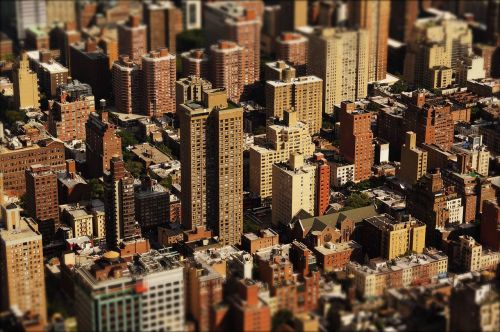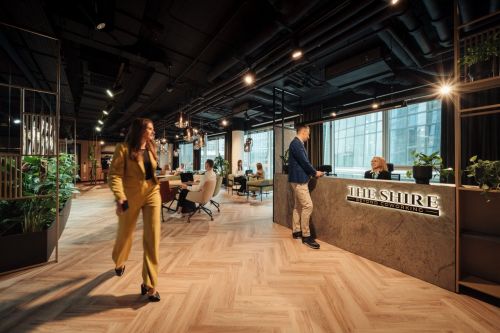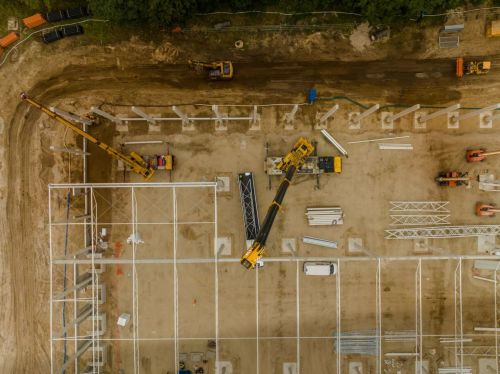Branded office buildings
Feature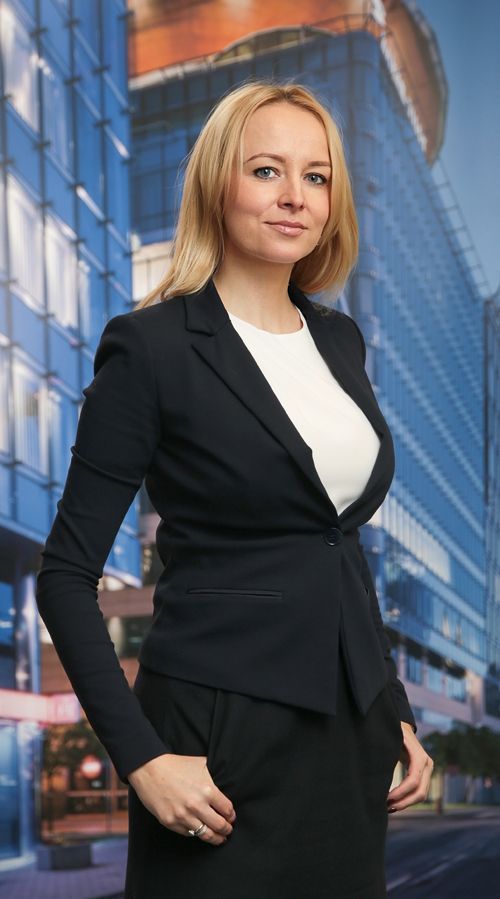
Myhive is the third brand that Immofinanz has introduced following the establishment of Vivo! and Stop Shop for its retail business “Introducing retail brands to the market has worked. The new office brand is part of A strategy the management agreed to a year ago. After analysing our portfolio, we decided that it had to be systemised, as a result we set up Myhive, and also liquidised those assets that weren’t office or retail buildings,” said Magdalena Kowalewska, the country manager operations Poland at Immofinanz. The first building under the Myhive brand in Poland is to be opened in mid-December this year with a total of 20 office buildings under the brand to be opened in the first stage, which should be fully implemented in 2018. These buildings include: Iride 19, Iride 20, S-Park, Metroffice, Viktoria Park in Bucharest; Pankrác House, Vinice in Prague; Greenpoint 7, Haller Gardens, Átrium Park, Thirteen (Globe & Xenter) in Budapest as well as Park Postępu, Crown Point, Brama Zachodnia, Nimbus, IO-1, Equator, S-Park in Warsaw and Twin Towers in Vienna and Hohenzollernring in Cologne. All of these buildings are currently being renovated. “We believe that by having a certain brand in a given sector, we can achieve more than holding onto and developing some random collection of office buildings and retail parks. Particularly when you take into account the scale we have. The strength of a brand is created by its uniformity. We don’t have to keep explaining to the client that we are building such and such a retail park, that it is located here, etc. etc. It’s enough just to briefly say ‘Stop Shop’, the name of the town or city and then ask, ‘Are you interested?’” explains Magdalena Kowalewska. The Myhive name itself comes from ‘my beehive’; “the name is associated with liveliness, productivity and efficiency. When one person goes in, another comes out. It’s full of energy and has a positive vibe. We want the brand to emphasise all these positive feelings that an office environment should evoke,” explains the head of Immofinanz in Poland. The Myhive name will not completely replace the current names of its buildings. If a building is called Crown Point, it is to become Myhive Crown Point after the changes are implemented.
Economies of scale
Vastint has come up with a similar idea for developing its Business Garden brand of office complexes. So far three such complexes have been created: in Warsaw, Poznań and Wrocław. More are planned as the developer carries out such projects in Poland, Romania and Latvia. The Business Garden brand is characterised by additional services, green areas within the complex and a ‘hospitality’ programme, providing employees with unique services and benefits, the quality of which is closely monitored. All of this is being implemented while working closely with the tenants. “On the one hand we would like our projects to each be unique, grabbing the tenants’ attention while at the same time being profitable on the commercial side; but on the other hand, we want them to reflect our belief that you can create quality with the use of standardisation. We make use of economies of scale as well as of the international reach of the concept we’ve created,” says Roger Andersson, the managing director of Vastint Poland. “This shortens the decision-making process, particularly with tenants that already occupy space in a Business Garden or have heard a lot about it. It will generally speed up the commercialisation of a project and of course it will impact revenues,” he adds. Immofinanz is counting on the same thing. “It often turns out that our tenants in Budapest, Bucharest and Warsaw are the same companies. We’re actively making use of the economy of scale,” says Magdalena Kowalewska. But consultants from JLL pour cold water on such enthusiasm. “If a tenant wants to rent space in another city it’s often an accident that they end up looking at the same brand. The technical specifications of such a building might be similar but typically that’s because of the developer and not the brand. So far I’ve not come across bulk transactions on the office market apart from a few cases such as IBM which leased space in The Park buildings in both Warsaw and Prague. However, in my opinion it was not the name of the buildings that mattered, but the complete benefit package as well as the company’s familiarity with the office development standards of this particular developer [White Star],” says Tomasz Czuba, director of the office leasing department at JLL. The developer does not agree. “Our current Business Garden tenants look at our business parks in other cities when locating their branches. It’s not always possible to coordinate project completion dates with our tenants’ business plans, but in most cases our projects are their first choices. We believe that their decisions are based on the fact that Business Garden parks meet their expectations,” says Roger Andersson and he goes on to add that tenants of Business Garden facilities usually include firms from the broad range of companies that constitute the shared service sector (BPO, SSC and IT).
Market expectations
“I’m not sure if an office building brand will work on the market and that other developers will follow this trend. In my opinion the standard of tenant service is more important and, if those of owners are equally high throughout their various locations and the changes made are not just cosmetic ones to the look of reception areas, then such an approach might lead to benefits – and it could also be beneficial for the tenants,” says Tomasz Czuba. “The concept behind our business parks is a response to market conditions and makes us stand out from other developers. It is not about using the same name but creating workplaces with the same characteristics and values. These are the pillars of the Business Garden concept. It is our fundamental difference,” explains Roger Andersson. Immofinanz claims something similar. “We believe that introducing the brand will give us a competitive advantage. This will be our characteristic feature for clients and agents. It will be something interesting that they can offer their clients. This is a distinctive feature of the select properties that fulfil Myhive’s criteria,” says Magdalena Kowalewska. Vastint also stresses the uniqueness of its concept. “Developers don’t work intensively on the brands of their projects. What can be seen on the real estate market is that development companies mostly invest in their own brand/name. The value of a project after its completion and sale is transferred to the developer’s own brand. Those values that are then associated with the developer’s brand are then transferred onto the next project. Vastint’s adopted strategy does not preclude this process in any way. A developer that manages to create value with a successful and unique business park concept can derive benefit from the repute of its brand and image on the market. However, when selling properties the strength of the project’s brand strengthens the brand of the new owner, which significantly impacts the value of the transaction,” says Roger Andersson and also points out that there is one more benefit: a shared brand also protects a given concept from imitation According to Tomasz Czuba, projects are mainly associated with a developer rather than a brand. And a brand does not necessarily translate into leases. Each lease transaction, particularly when it is of a considerable size, is negotiated separately anyway. “So far what’s been of greatest importance are the technical specifications of a building so developers have tried to fit their project into their specific surroundings, making each one stand out in a different way (such as via its architecture or its energy efficiency) because emotions count more when leasing offices than in the retail market. In my experience the projects of Skanska, which the company calls Green, as well as those of Vastint, have been much more associated with the developer than with the brand,” he explains. And what does Skanska have to say about its Green brand? “We originally didn’t intend to make greenness the feature of a new brand, the word ‘Green’ was just meant to underline the features of our buildings,” says Sylwia Chorąży, the marketing, sustainability and innovation director of Skanska Commercial Development Europe. “They were named this way because they had been built according to the highest sustainable coonstruction standards – and this still forms the soul of these projects. However, now we understand the sustainability approach in a slightly different way than several years ago. Now we have a human focus, because everything starts with us. Due to this change, the function and meaning of names we give to buildings has also changed. Now the whole context of where the building is located is important. It is not just its walls, but a place we create, determined by the many people who visit it every day, by local history, by the urban fabric, the neighbourhood and the characteristics of the local community. Of course, the architecture and features of a building are still important, but so are social trends, such as integrating different generations in Generation Park or the energy of youth in High5ive in Kraków,” adds Sylwia Chorąży.
Investing in rocking horses
Immofinanz has spent EUR 10 mln introducing its Myhive brand. The marketing costs came to app. EUR 1 mln with the rest being used to finance the renovation of the communal areas. The lobbies of all 20 Myhive buildings are to be identical. Their interiors were designed by architect Katharina Fröch from Beainteriors. The design was preceded by a survey of all the tenants as well as visits to each of the company’s properties with the work taking a year. Each lobby will have the same furniture, including a rocking horse, which will help break down the solemnity and coldness normally associated with office buildings. There will also be a lot of seating. “The furniture has been designed especially for these projects, which has involved long visits by the architects to these centres,” says Magdalena Kowalewska. Most of the furniture for the lobbies was manufactured by Wohnzeile4 Einrichtungs. There will be more greenery, background music and the same smell in each lobby. As Immofinanz Poland admits, these are ideas that have been copied from retail projects, because, as the company claims, a brand can be managed through the senses. Also, the personal touch with polite, flexible and helpful staff is to be a strong feature of the Myhive brand. Reception staff are currently being recruited. “We’re hiring people from the hotel industry because they have top customer service skills. The atmosphere of a Myhive office building is to be similar to that of a boutique hotel. We created our brand standards mostly on the basis of the response to a survey of our clients. There was the idea of creating a virtual reception area but the tenants didn’t like that,” admits Immofinanz. The company says that it does not want Myhive to only be associated with a pretty lobby. “Changes to the lobby architecture are just an additional feature. What’s most important is the creation of a communal area. The lobby is there so that tenants and employees from various companies can talk. Our tenants said that they wanted to have a place where they could meet and do business with other tenants. We are long-term investors. Keeping our clients is the top priority for us. Myhive is a response to the challenges of the market,” says Magdalena Kowalewska. The Myhive brand denotes buildings in good locations of a certain size – they cannot be too small. Additionally, in order to become part of the Myhive brand, a building has to include a restaurant. “It doesn’t have to be a top quality restaurant but nor can it be just an ordinary canteen. Niezły Kocioł which was recently opened in our building on ul. Postępu is a good example,” says Magdalena Kowalewska. Immofinanz is not introducing concierge services as part of its standards. If there is a demand for them, they can be provided at extra cost. “We’re not planning to increase our fees for the basic Myhive offer. We’re showing that we’re a large player and that we’re making an effort to meet our clients’ needs, even those they themselves are not yet aware of,” she says.
One step at a time
Those properties that are not to become part of the brand are to stay in the Immofinanz portfolio. Nothing is going to change. “They are important to us because we find diversification works. We have a product for nearly every tenant,” says Magdalena Kowalewska. Some of these properties will join the Myhive brand in future stages. Immofinanz is not able to say how many buildings will eventually come under the Myhive brand. “The first stage of the project is still underway. We’ll see what the response to the changes will be. The first stage is to be completed in 2018. In the meantime we’re going to start the necessary analyses for the second stage, before we’ve completed stage one. We’re going to go visiting again,” says the Immofinanz representative. So far the company has not considered introducing another office building brand of either a higher or a lower standard. “One office brand is enough for now, we’re focusing on establishing it,” she says.

























